
I ordered a copy of this MARVEL TREASURY EDITION featuring the Fantastic Four from the Superhero Merchandise catalog–or as the firm would later be known, Heroes World. They had bought out Marvel and DC’s back-stock of their various Treasury Editions and would sell them for years thereafter, often advertising in the comics themselves. I eventually wound up with three copies of this beauty; after a while, Superhero Merchandise had a deal where if you ordered a certain dollar amount of stuff, you would get an additional gift. Apparently, they simply had too many of these books on hand to ever get rid of them all, so they became sales incentives, and I wound up with a couple more copies of it.
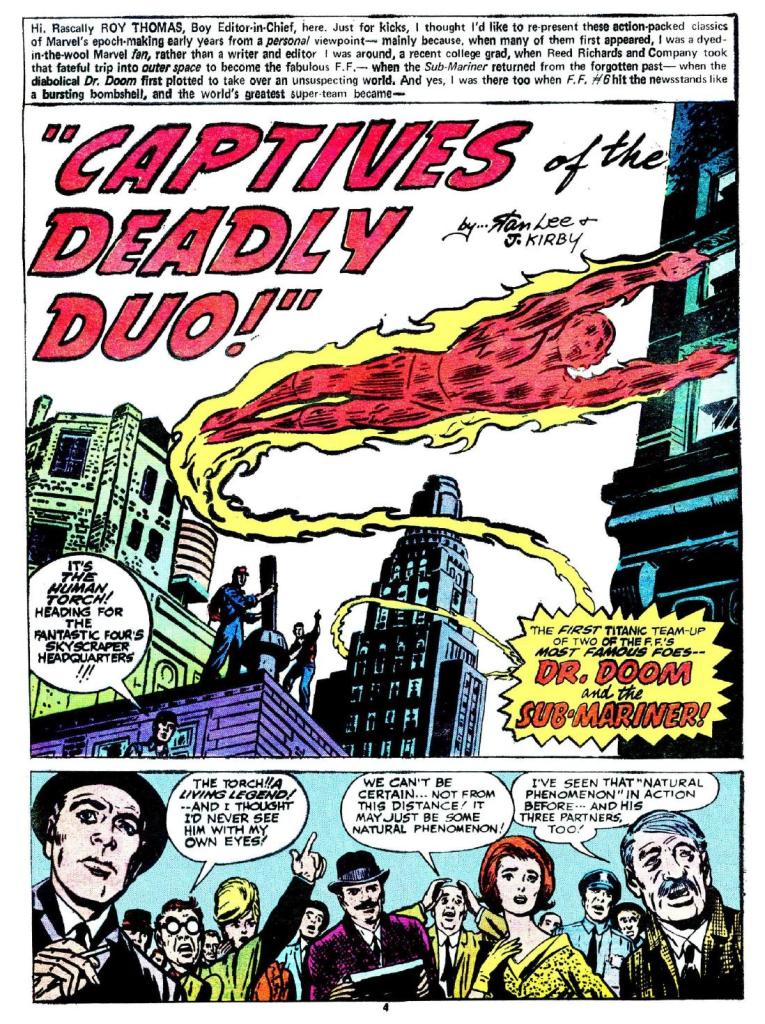
In these days before the advent of trade paperbacks or regular collections, these Treasury Editions fulfilled that role. They were printed squarebound with way better cover stock, and the fact that they were a bit of an unwieldy size to store was made up for by the fact that they made the artwork seem massive and all-encompassing. That was noteworthy in this book, which reprinted a truncated version of the Galactus Trilogy, my first exposure to it. The first story, though, was a reprint of FANTASTIC FOUR #6, which I already owned in the FF Pocket Books edition I had previously purchased. Fortunately, this was the only story in the issue that I had already read.
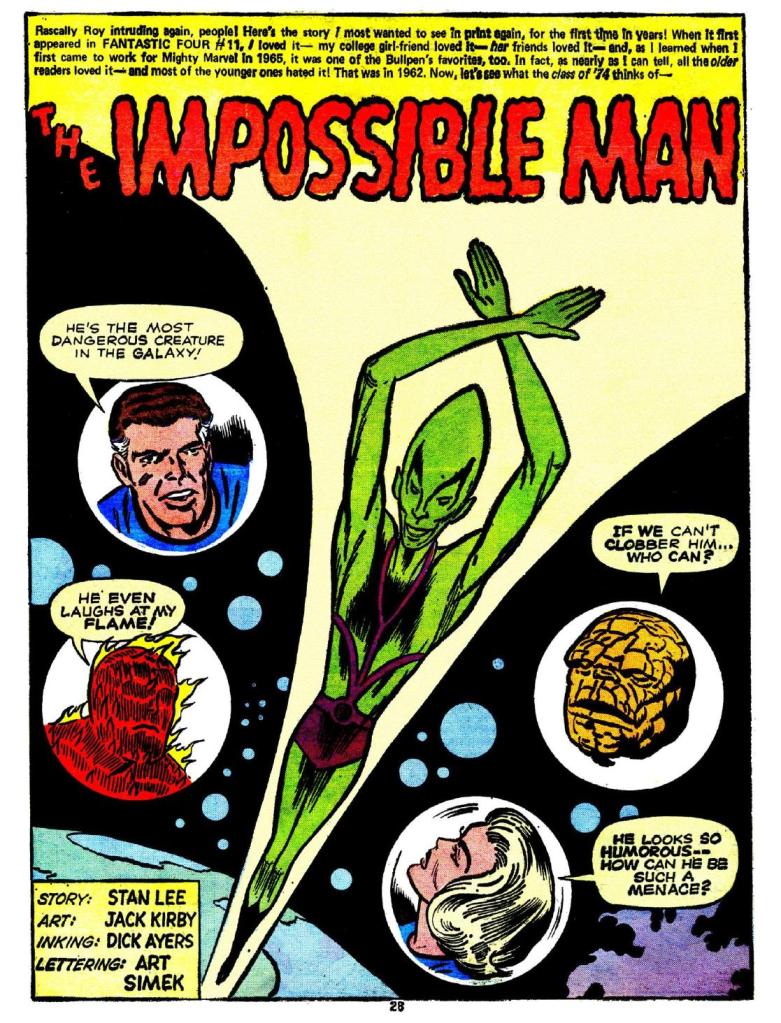
Next reprinted was the two stories that had seen print in FANTASTIC FOUR #11, though editor Roy Thomas here switches the order of them, leading off with the introduction of the Impossible Man. Roy had a real soft spot for the Impossible Man based on having read this story as a reader, and even brought him back somewhat over publisher Stan Lee’s objections (Stan recalled all of the negative fan mail they’d received when this issue first came out.) It’s a relatively absurd story, very much in the mold of something that might have seen print in Simon & Kirby’s FIGHTING AMERICAN. I didn’t hate it, but neither did I love it.
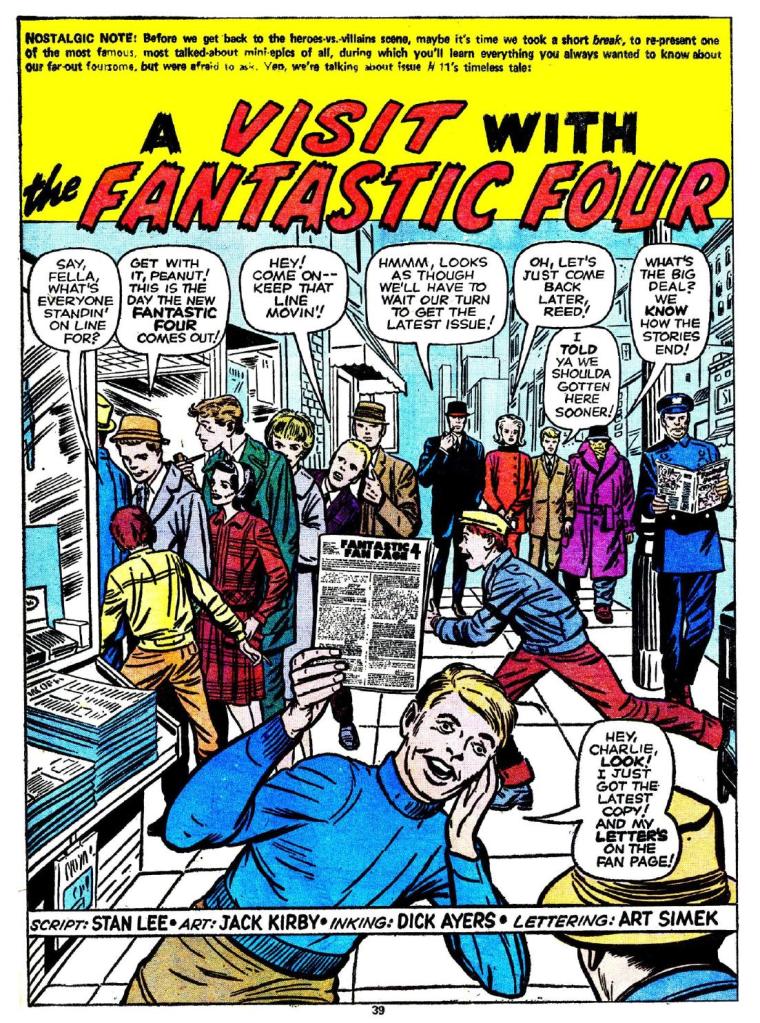
The next story was almost less of a story than it was a number of connected vignettes designed to answer as many reader questions as possible about the Fantastic Four and their background. This is where Reed and Ben’s long friendship was first established–prior to this, Ben was intended to have been just a pilot that Reed had hired for their flight. It’s also the story that introduced the idea that both Reed and Ben had served in the military during World War II while Sue was the girl who waited for Reed on the homefront–an idea that maybe worked all right in 1963 (except Sue’s age, even then) but which swiftly became problematic, and was eventually dropped. It’s also got a very strange defense of Sue’s position on the team, likening her to Abraham Lincoln’s mother. And it’s the introduction of the Marvel Universe version of Willie Lumpkin, the FF’s ear-wiggling mailman who was named after the star of an earlier newspaper strip done by Lee and Dan DeCarlo.
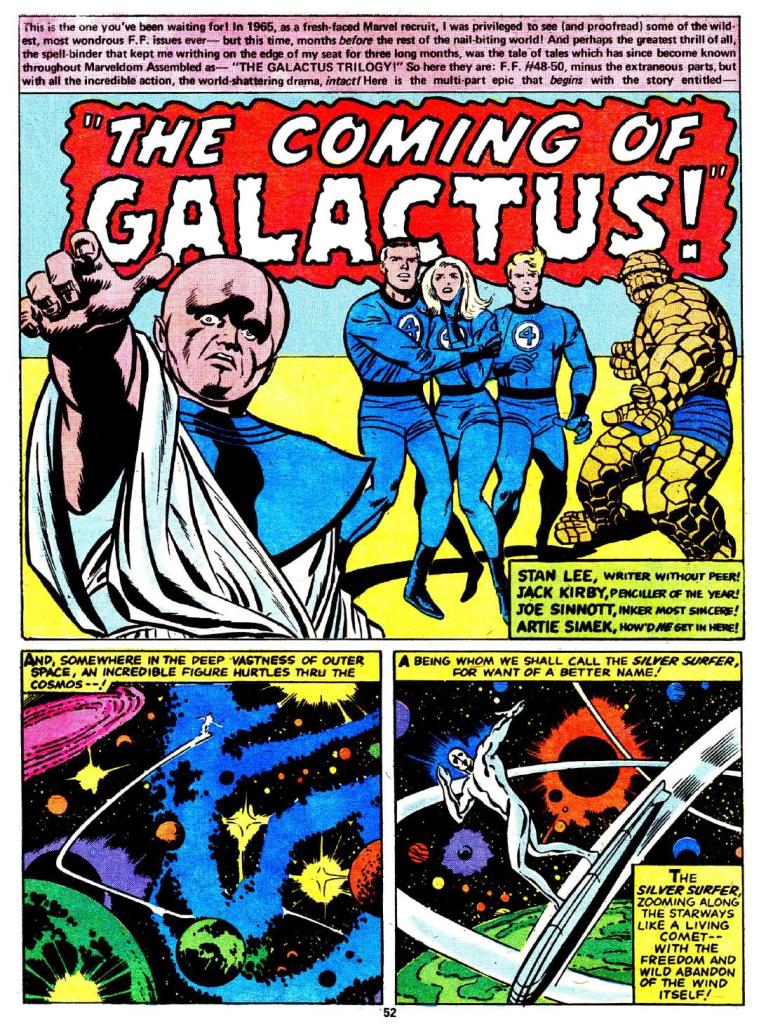
After a great double-page pin-up by John Buscema and Frank Giacoia, it’s time for the main event: the Galactus Trilogy, in all its original wonder. The fact that I read this story for the first time in this oversized format probably added to its power and majesty. This was where Lee and Kirby as well as inker Joe Sinnott had really hit their stride, combining their skills into an amalgamation that was greater than the sum of its parts. Certainly, even in 1978, there wasn’t much in the world of pop culture that could compete with the awesome spectacle of this story. As I mentioned earlier, in order to make the page count fit, portions of #48 and #50 were excised–but those portions were mostly either the wrap-up of the prior Inhumans story or the set-up for future adventures. It has to be said, the pacing on some of these issues got pretty odd.
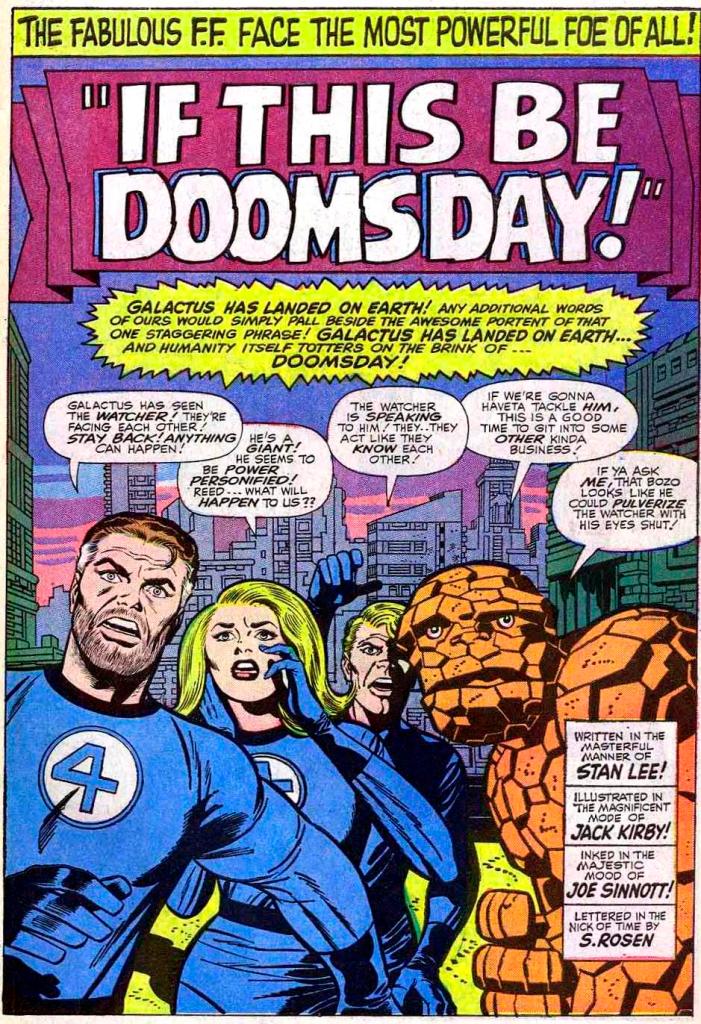
After all of these years, I expect that the story is well-known. But just to recap it for the uninitiated: the FF are returning home to the Baxter Building when first flames and then a horde of asteroids appear in the sky. This is the work of the Watcher, who as broken his oath of non-interference in order to attempt to conceal the Earth from Galactus, the planet devourer. But to no avail–Galactus’ galaxy-seeking herald (and Jack Kirby’s whole cloth contribution to the story) the Silver Surfer has located the Earth and summons Galactus before the Thing can belt him across town. Galactus is unbelievably powerful, consuming entire worlds for the nourishment that he needs, and nothing the FF does seems to be able to even slow him down.
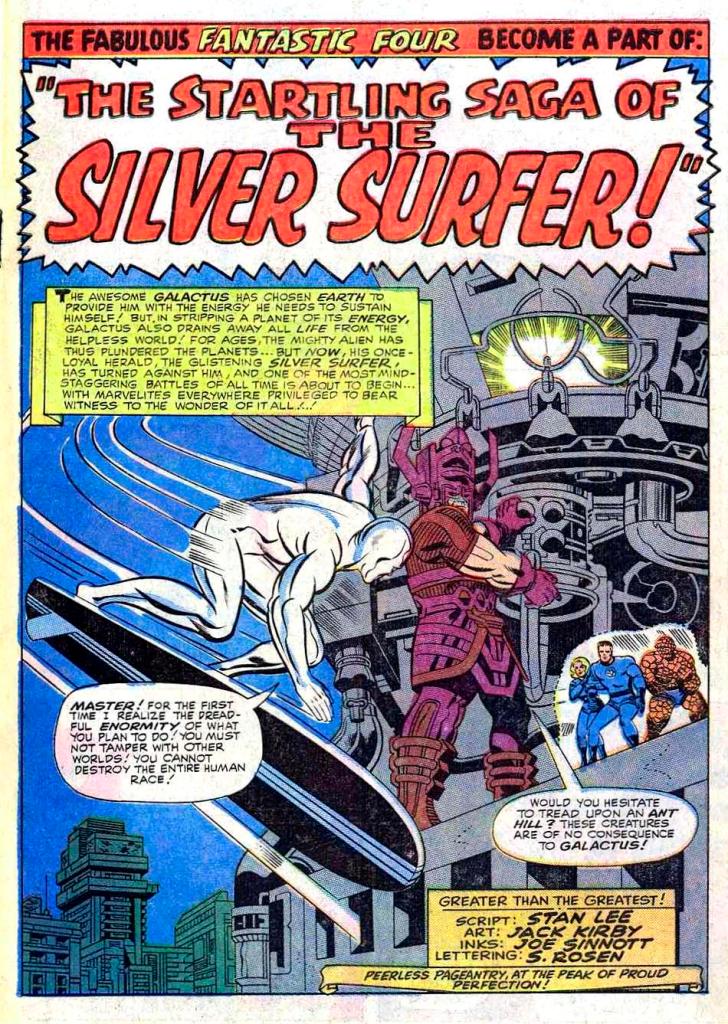
But in the sort of plot flukery that we would never forgive today, the Surfer has landed at Alicia Masters’ sculpting studio, and the Thing’s blind girlfriend succeeds in awakening some empathy within the sky-rider. The Surfer returns to challenge Galactus while the FF are reduced to helpless spectators. All but Johnny Storm, whom the Watcher has sent on a cosmic journey to Galactus’ world-ship to retrieve the one device which might drive him off: the Ultimate Nullifier. Confronted with the Nullifier, Galactus relents–but not before stripping the Surfer of his space-time powers and trapping him on Earth for his act of rebellion. This edit of the story ends with Alicia running to embrace the Surfer, ignoring the suddenly-depressed Thing, who figures she’ll throw him over for the cosmic visitor from space. It’s a big story, but one studded with little human touches (such as Reed shaving and washing up) that keep it grounded and believable.
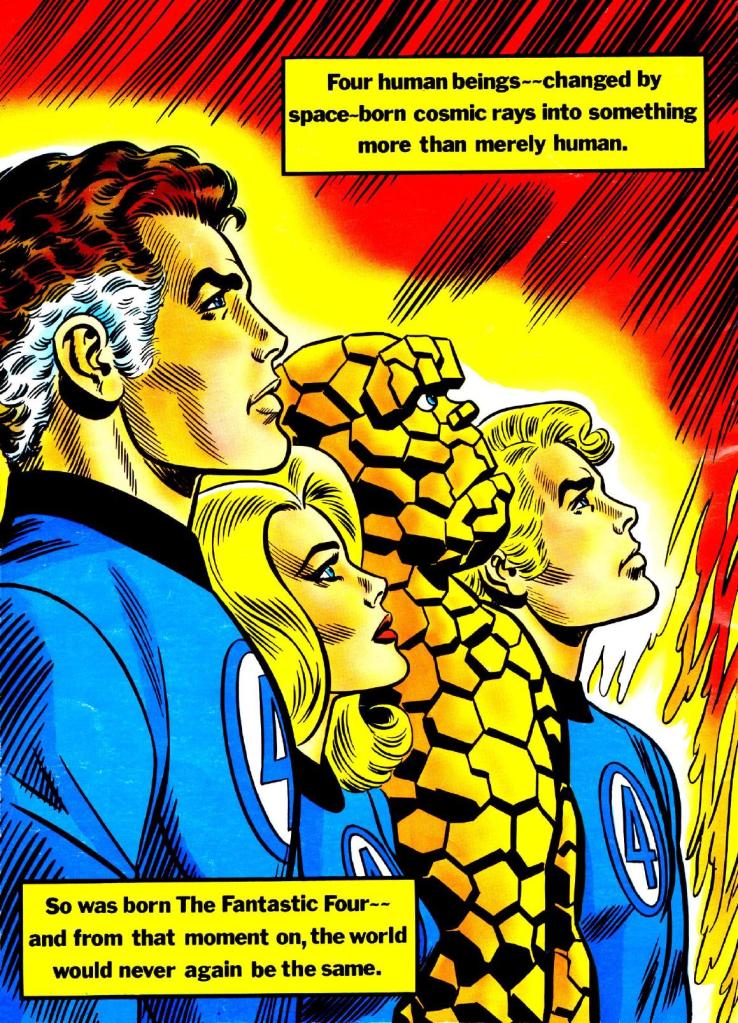
Both the front and back covers of this oversized book by John Romita are also terrific, and they would both be used quite often in the coming years on merchandise of a variety of types. These early MARVEL TREASURY EDITIONS were put together with care and deliberation, in an attempt to make them editions that would last the test of time. Eventually, the format just became oversized reprints, but for the first half-dozen or so, I believe people were considering these to be a more permanent library of Marvel stories, in the absence of Masterworks volumes and other collected editions. This was also the first use of the logo that would run on the series for most of the rest of the 1970s–the four character-circles were taken from the frontispiece.

I remember my momma buying this for me one weekday evening back in 1974 from 7-eleven. Fell in love with that one panel of the planet Popup with all those weird monstrosities. For some reason my memory of this book is intertwined with various songs from Stevie Wonder’s album Innervisions that were on the radio then. T’was a good time.
LikeLiked by 1 person